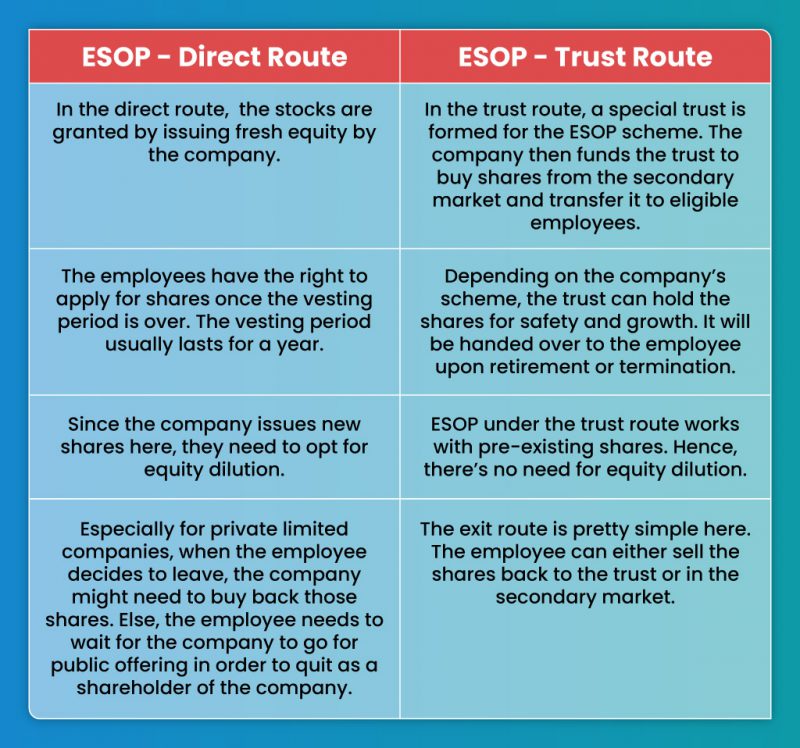
ESOP Trust – How to set up an ESOP Trust
Retaining quality talent is impossible unless you compensate them well for their efforts. However, one of the biggest problems most startups face is funding and cash flow and this hampers their ability to retain their good employees. Nevertheless, an easy solution to this problem is to offer stocks through an ESOP trust (Employee Stock Option Plan Trust).
In a 2021 ESOP survey, it was found that 30% of Indian companies have already implemented an ESOP plan and 8% are planning to do so soon. This shows that the concept of ESOP has already found a strong ground in India. Given that 30% of the companies currently have an ESOP system, it’s safe to state that it is definitely a profitable arrangement.
All You Need To Know About ESOP Trusts
What Is an ESOP Trust?
ESOP trusts are private entities formed by a company. They are not to be mistaken for charitable trusts.
These trusts allow the employees to buy company stocks at a rate lower than the current market price. This usually compensates for a certain percentage of the employee’s salary through stocks.
The ESOP trust is not mandatory, and employees are free to refuse. However, it has proved beneficial for both the company and employees which has led to its widespread acceptance, especially among startups.
Mechanism of ESOP Trust
The trust route is a technique of issuing shares in accordance with the ESOP scheme. An ESOP Trust is founded and registered exclusively for the purpose of carrying out an ESOP Plan. A company writes a scheme and has it authorized by the company’s members. Concurrently, an ESOP Trust is established and registered under the Indian Trust Operate of 1882 to act as an intermediary between the employees and the company. The ESOP Trust is responsible for granting shares to employees as and when option holders exercise their options.
Because the ESOP Trust option does not require the company to dilute its current capital base, listed companies prefer it for secondary market share purchase. Employees have an easier time exiting through the ESOP Trust mechanism than through the ESOP Direct method. As a result, once the options are exercised, it offers liquidity to the employees.
Parties to ESOP Trust formation
The parties to the ESOP Trust formation are
Trustee: A property owner who is obligated to use his property for the benefit of another. Except for the following, anyone can be designated as the trustee of the ESOP Trust:
- The company’s directors, key management personnel, and their families, as well as its holding, subsidiary, or affiliate company
- Any person who beneficially owns more than 10% of the company’s paid-up share capital.
Settlor: The company that has created an ESOP Trust. Settlor is also known as Grantor or Trustor
Beneficiary: The owner who benefits from the Trust property, i.e. the company’s employees.
Laws Governing ESOPs & Eligibility Criteria For Employees
The laws governing ESOPs in India are different for listed and unlisted companies. When it comes to unlisted companies, the Companies Act 2013 and the Companies (Share Capital and Debentures) Rules, 2014 govern the ESOP trust.
As for listed companies, the ESOP trust is issued in accordance with the Securities and Exchange Board of India Employee Stock Option Scheme Guidelines.
As a startup, you might have your own specific criteria for employee eligibility based on their years of experience or skills. But according to the Companies (Share Capital and Debentures) Rules, 2014 that governs ESOP trusts, generally, all employees are eligible for the scheme who are:
- Permanent employees of the company
- Employees of the parent company’s subsidiary, or associate company
What Are The Options Available To Set Up An ESOP
Before setting up an ESOP trust, it is important to know what options you have to set it up. There are two routes to set up an ESOP.
- The Direct Route
- The Trust Route
To help you understand the difference between the two routes better, here is a comparative explanation of the two.

This article discusses how ESOP is established and run under the trust route. Although it requires a lot more legal formalities, it does compensate for that by boosting the ROI.
Benefits of an ESOP Trust
There could be a number of reasons for companies to use the ESOP Trust structure to manage their employee stock options, some of which are listed below.
- An independent body can provide better governance and implementation.
- Because there is no market for unlisted firms’ securities, it can provide a simple means of encashment for their employees.
- From the perspective of the employer, it provides a secure and adaptable platform for implementing stock option plans to reward and retain talent, saving time and human capital in the process.
- From the perspective of the employees, an ESOP Trust can motivate them through an autonomous and independent structure with transparent rules, reducing disputes between the employer’s shareholders and the employees.
Setting Up an ESOP Trust For Employees: A Step-By-Step Guide
Here is a detailed guide to help you avoid some common mistakes while granting stocks and set up an ESOP trust for your company seamlessly..
1. Formation of a Compensation Committee
The first step is to create a compensation committee. The committee will be constituted of the board of directors with independent directors in the majority. This committee will govern the formation of the ESOP and lay down the rules and guidelines for the same.
2. Listing Eligible Employees
Before you get into the legalities, you need to prepare a list of eligible employees for this scheme. The list has to be drawn up taking their experience, expertise, as well as legal guidelines into consideration.
3. Drafting The ESOP Policy
The next step is to draft the policy that will govern the operation of the ESOP trust in accordance with SEBI’s guidelines .
These are a few things that you need to keep in mind while drafting this policy:
- The eligibility criteria of the employees
- The rights of the employees under the scheme
- The rights of the shareholders
- The quantum of the ESOP pool
- Terms & conditions to exit the scheme
- The tax liabilities.
4. Approval By The Board
Once a list of eligible employees is prepared and the ESOP policy is drafted, it is time to get it approved by the board. The board has to approve all the ESOP policies as well as the list of eligible employees. Along with that, a notice to hold a general meeting for the shareholders’ consent also has to be prepared.
5. A General Meeting With Shareholders
A general meeting has to be conducted with the shareholders to get their approval to issue company stocks to the employees. The approval needs to be passed by an ordinary resolution (a resolution passed by a simple majority) . However, the authority to grant the ESOP scheme to the employees remains only with the compensation committee.
6. Registration of The Trust
A trust deed has to be drawn and the ESOP trust has to be registered under The Indian Trust Act, 1882 . Also, a board of trustees will be formed which will be controlled by the company. In addition, the Trust will have to be registered under the Income Tax PAN before it can start operating.
7. Funding The Trust
The trust has to be funded with stocks. For this the company needs to give the trust a loan. The stocks can be provided in any of these three ways:
- The owner of the organization can sell some of his stocks to the trust
- Fresh stocks can be allotted to the trust by the company
- Stocks can be bought from existing shareholders.
8. Issuing The Shares To The Employee
To issue the shares to the employee, the Share Transfer Form (Form 7B) has to be implemented by the trustees and the employee receiving the stocks. Moreover, for the employee to become an official shareholder of the company, the form also needs to be approved during the board meeting. Once the transfer is approved, a shares certificate has to be issued, followed by updating the Register of Members.
9. Implementation Of The Lock-in Period
The period between the grant of the stocks and when the employee actually receives authority over the stocks is known as the lock-in period. Generally, this period lasts for about a year.
Factors to be considered while creating ESOP Trust
There are many factors that must be considered before adopting a Trust structure. They are:
- The Company will have to fund the ESOP Trust in order for the Company’s shares to be subscribed to. A specific resolution must be passed in a general meeting to authorize the scheme for the provision of funds. Purchase from a recognized stock exchange if the company is publicly traded.
- If the company is not publicly traded, an independent registered valuer will value the shares purchased by the trust.
- It’s also crucial to keep in mind who can serve as an ESOP Trust trustee, as certain restrictions apply to directors, key management personnel, their relatives, and anyone with beneficial ownership of more than 10% of the paid-up share capital.
- Additional criteria or compliance are applicable to listed firms based on SEBI laws, such as the value of shares to be bought, secondary acquisition, explanatory statement to notice of general meeting, voting rights, and so on.
- The ESOP Trust approach is more complicated and necessitates legal compliance such as ESOP Trust registration, ESOP Trust PAN registration, and the execution of an ESOP Trust Deed, among others.
What Is The Exit Mechanism From An ESOP Trust?
Although the trust route for an ESOP is considered more complicated than the direct route, the exit mechanism is comparatively easier in the trust route.
All that the employee has to do is either sell it back to the trust or in the secondary market. Under the Company Act, 2013, the trust can buy back the shares from the secondary market using a loan from the company.
Final Thoughts
ESOPs are not just rewarding for employees but also for the company. It leads to higher productivity, higher employee retention, and also more profit. Along with this, employers also enjoy massive tax benefits because the loans offered to the trust to buy shares are non-taxable. Start-ups’ tax benefits are a blessing since they help you save and re-invest in the company.
Need help creating or rolling out ESOPs? Do you want to streamline ESOP management? Get in touch with our team.
ESOP & CAP Table
Management simplified
Get started for free

